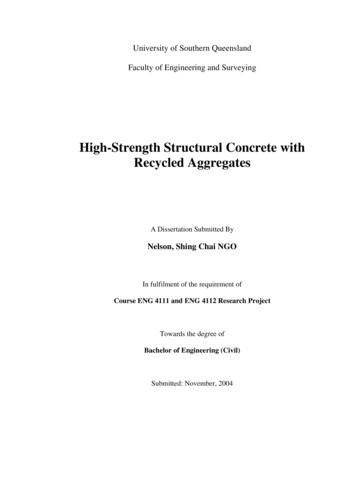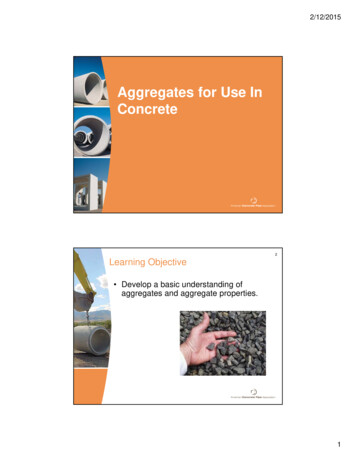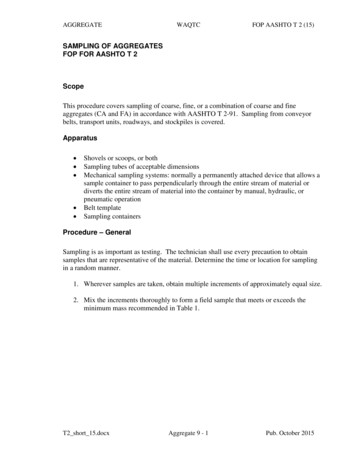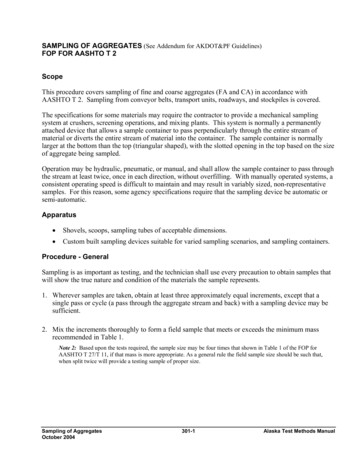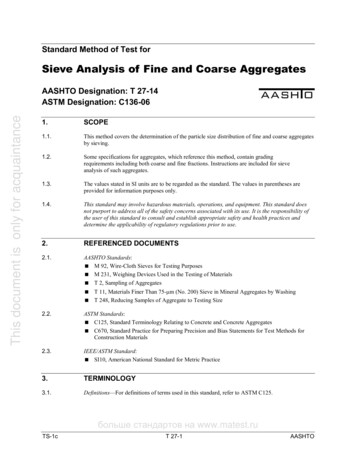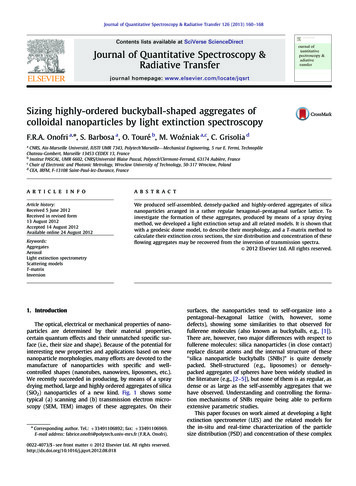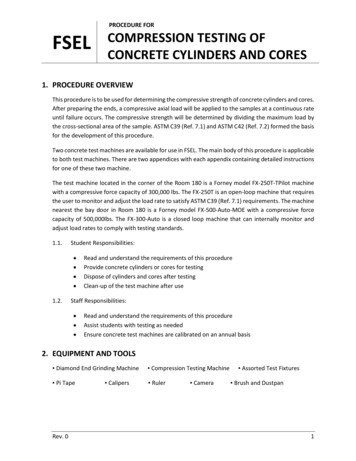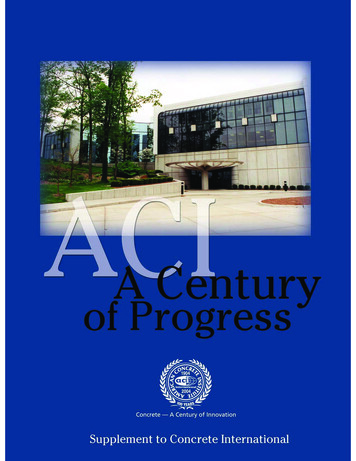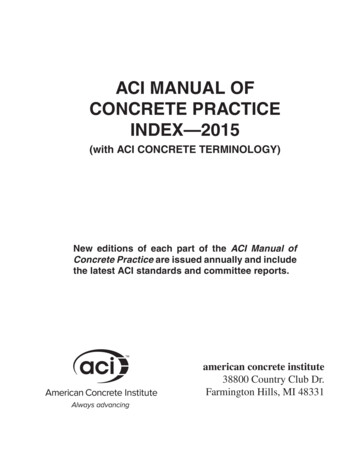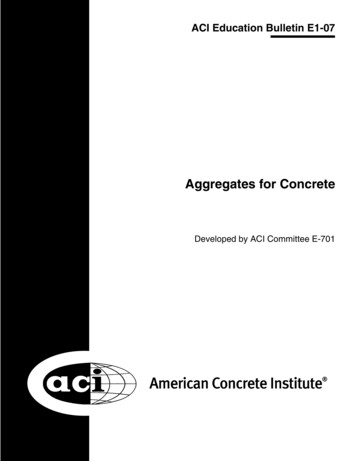
Transcription
ACI Education Bulletin E1-07Aggregates for ConcreteDeveloped by ACI Committee E-701
First PrintingAugust 2007 American Concrete InstituteAdvancing concrete knowledgeAggregates for ConcreteCopyright by the American Concrete Institute, Farmington Hills, MI. All rights reserved. This materialmay not be reproduced or copied, in whole or part, in any printed, mechanical, electronic, film, or otherdistribution and storage media, without the written consent of ACI.The technical committees responsible for ACI committee reports and standards strive to avoid ambiguities,omissions, and errors in these documents. In spite of these efforts, the users of ACI documents occasionally find information or requirements that may be subject to more than one interpretation or may beincomplete or incorrect. Users who have suggestions for the improvement of ACI documents arerequested to contact ACI.ACI committee documents are intended for the use of individuals who are competent to evaluate thesignificance and limitations of its content and recommendations and who will accept responsibility for theapplication of the material it contains. Individuals who use this publication in any way assume all risk andaccept total responsibility for the application and use of this information.All information in this publication is provided “as is” without warranty of any kind, either express or implied,including but not limited to, the implied warranties of merchantability, fitness for a particular purpose ornon-infringement.ACI and its members disclaim liability for damages of any kind, including any special, indirect, incidental,or consequential damages, including without limitation, lost revenues or lost profits, which may resultfrom the use of this publication.It is the responsibility of the user of this document to establish health and safety practices appropriate tothe specific circumstances involved with its use. ACI does not make any representations with regard tohealth and safety issues and the use of this document. The user must determine the applicability of allregulatory limitations before applying the document and must comply with all applicable laws and regulations, including but not limited to, United States Occupational Safety and Health Administration (OSHA)health and safety standards.Order information: ACI documents are available in print, by download, on CD-ROM, through electronicsubscription, or reprint and may be obtained by contacting ACI.Most ACI standards and committee reports are gathered together in the annually revised ACI Manual ofConcrete Practice (MCP).American Concrete Institute38800 Country Club DriveFarmington Hills, MI oncrete.orgISBN 978-0-87031-248-9
ACI Education Bulletin E1-07AGGREGATES FOR CONCRETEDeveloped by Committee E-701,Materials for Concrete ConstructionDavid M. Suchorski,ChairLeonard W. BellMorris S. HuffmanRichard BohanColin LoboKenneth RearJere H. RoseDavid BurgStella L. MarusinPaul J. TikalskyDarrell ElliotIbrahim MetwallyKari YuersJames A. FarnyCharles NmaiRobert ZellersJose P. GarciaAnthony C. PowersNote: Special credit is extended to Ward R. Malisch, who developed the first edition and made aneditorial contribution to this edition.CONTENTS3.4—Bulk density (replaces de-emphasized term “unit weight”)3.4.1—Definition and test method3.4.2—Factors affecting bulk density3.5—Particle shape, angularity, and surface texture3.5.1—Definition3.5.2—Test methods3.5.3—Significance of particle shape and surface texture3.6—Abrasion and impact resistance3.6.1—Definition and significance3.6.2—Test method3.7—Soundness3.7.1—Definition and mechanism of deterioration3.7.2—Test methods3.7.3—Pop-outs3.8—Chemical stability3.8.1—Definition and reaction mechanisms3.8.2—Test methods3.8.3—Corrective measures3.9—Harmful substances in aggregates3.9.1—Types of harmful substances3.9.2—Effects of harmful substances3.9.3—Test methodsChapter 1—Introduction, p. E1-2Chapter 2—Classification of aggregates, p. E1-2Chapter 3—Aggregate properties and testmethods, p. E1-23.1—Grading3.1.1—Definition and test method3.1.2—Fineness modulus3.1.3—Maximum size and nominal maximum size3.1.4—Significance of aggregate grading3.1.5—Permissible variations in grading3.2—Specific gravity (relative density)3.2.1—Definition3.2.2—Determination of specific gravity3.2.3—Significance of specific gravity3.2.4—Absolute volume calculations3.3—Absorption and surface moisture3.3.1—Mixing water and water-cementitious materialratio3.3.2—Absorption and total moisture content3.3.3—Surface moisture content3.3.4—Computing mixing water and water-cementitiousmaterial ratio3.3.5—Adjusting batch masses for surface moisture3.3.6—Alternate definition of surface moistureChapter 4—Sampling aggregates, p. E1-204.1—Variability in Significance of variabilityThe Institute is not responsible for the statements oropinions expressed in its publications. Institute publicationsare not able to, nor intended to, supplant individualtraining, responsibility, or judgment of the user, or thesupplier, of the information presented.ACI Education Bulletin E1-07. Supersedes E1-99.Copyright 2007. American Concrete Institute.All rights reserved including rights of reproduction and use in any form or by anymeans, including the making of copies by any photo process, or by electronic ormechanical device, printed, written, or oral, or recording for sound or visual reproductionor for use in any knowledge or retrieval system or device, unless permission in writing isobtained from the copyright proprietors. Printed in the United States of America.E1-1
E1-2ACI EDUCATION BULLETIN4.2.3—Sampling plans4.2.4—Sampling methods4.2.5—Number and size of field samples4.2.6—Sample containersChapter 5—Blast-furnace slag aggregates, p. E1-215.1—Blast-furnace ailabilityChapter 6—Lightweight aggregates, p. E1-216.1—Introduction to lightweight aggregates6.2—Definition of lightweight-aggregate concrete6.3—Low-density concretes and associated aggregates6.3.1—Structural lightweight concrete and associatedaggregates6.3.2—Moderate-strength lightweight concrete andassociated aggregates6.3.3—PropertiesChapter 7—Recycled aggregates, p. E1-237.1—Introduction to recycled ter 8—Selected references on aggregates,p. E1-24Chapter 9—Glossary, p. E1-25CHAPTER 1—INTRODUCTIONHydraulic cement concrete is a cement and water paste inwhich aggregate particles are embedded. Aggregate is granularmaterial such as sand, gravel, crushed stone, blast-furnaceslag, and lightweight aggregates that usually occupies approximately 60 to 75% of the volume of concrete. Aggregateproperties significantly affect the workability of plasticconcrete and also the durability, strength, thermal properties,and density of hardened concrete.This Bulletin describes types of aggregates normally usedin concrete, aggregate properties affecting performance ofthe concrete, tests used to measure aggregate properties, andmethods used to obtain test samples. Normalweight as wellas lightweight aggregates are discussed.The measurement system used in this Bulletin is the International System of Units, or SI Units. Accordingly, readersshould make particular note that the term “weight” has beenreplaced with “mass,” and “unit weight” has been replacedwith “density” when used in reference to the absolute volumeaggregates occupy in concrete, and with “bulk density”when used in reference to aggregates, such as the mass perunit volume of a collection of graded aggregate particles ascompacted in a volumetric bucket or the relation of mass tovolume of aggregates in a stockpile or bin. As a convenience,most of the examples provided in the Bulletin are in both SIand U.S. customary (in.-lb) units.Frequent references are made to ASTM International(ASTM) standards. These include test methods, definitions,recommended practices, classifications, and specificationsthat have been formally adopted by ASTM. New editions ofthe ASTM Book of Standards are issued annually, and allreferences to these standards in this Bulletin refer to the mostrecent edition. Organizations such as ACI and others havesimilar or additional standards that may be applicable.CHAPTER 2—CLASSIFICATION OF AGGREGATESAggregates may be broadly classified as natural or artificial,both with respect to source and to method of preparation.Natural sands and gravels are the product of weathering andthe action of wind or water, while manufactured crushed fineaggregate and crushed stone coarse and fine aggregate areproduced by crushing natural stone. Crushing, screening,and washing may be used to process aggregates from eithersand and gravel deposits or stone quarries. Aggregatesmay be produced from igneous, sedimentary, or metamorphicrocks, but geological type does not by itself make an aggregatesuitable or unsuitable for use in concrete. The acceptance ofan aggregate for use in concrete on a particular job or inmeeting a particular specification should be based upon specificinformation obtained from tests used to measure the aggregate’squality or, more importantly, its service record, or both.More performance tests are also used to test aggregates inconcrete. A typical consensus specification for fine and coarseaggregate for concrete is ASTM C 33.Synthetic aggregates may be either byproducts of an industrialprocess, in the case of blast-furnace slag, or products ofprocesses developed to manufacture aggregates with specialproperties, as in the case of expanded clay, shale, or slateused for lightweight aggregates. Some lightweight aggregatessuch as pumice or scoria also occur naturally.Other classifications of aggregates may be based on bulkdensity, (previously termed “unit weight”) (ASTM C 33, C 330,and C 637), mineralogical composition (ASTM C 294), andparticle shape, but these, as well as the ones previouslydiscussed, serve mainly as aids in describing an aggregate.To understand the role played by aggregate in the performanceof concrete, it is necessary to define specific aggregate propertiesand show their effect on concrete properties.CHAPTER 3—AGGREGATE PROPERTIESAND TEST METHODS3.1—Grading3.1.1 Definition and test method—Grading refers to thedistribution of particle sizes present in an aggregate. Thegrading is determined in accordance with ASTM C 136, “Sieveor Screen Analysis of Fine and Coarse Aggregates.” A sampleof the aggregate is shaken through a series of wire-clothsieves with square openings, nested one above the other inorder of size, with the sieve having the largest openings on top,the one having the smallest openings at the bottom, and a panunderneath to catch material passing the finest sieve (Fig. 1).Sieve sizes commonly used for concrete aggregates are detailedin Table 1, and various physical properties of normalweightaggregates, with typical range values, are shown in Table 2.Coarse and fine aggregates are generally sieved separately.That portion of an aggregate passing the 4.75 mm (No. 4)
AGGREGATES FOR CONCRETEE1-3Table 1—Sieves commonly used for sieve analysisof concrete aggregatesNominal sieve openingStandard sieve designation(ASTM E 11)mmin.Coarse sievesStandardAlternate75.0 mm3 in.75.0363.0 mm2-1/2 in.63.02.550.0 mm2 in.50.0237.5 mm1-1/2 in.37.51.525.0 mm1 in.25.0119.0 mm3/4 in.19.00.7512.5 mm1/2 in.12.50.59.5 mm3/8 in.9.50.3754.75 mmNo. 44.750.18702.36 mmNo. 82.360.09371.18 mmNo. 161.180.0469600 μm*No. 300.600.0234300 μmNo. 500.300.0117No. 1000.150.0059Fine sievesFig. 1—Nest of sieves.150 μmFinest sieve normally used for aggregates75 μm*No. 2000.0750.00291000 µm (micro-meters) 1 mm.Table 2—Ranges in physical properties for normalweight aggregates used in concreteProperty2.0 to 3.3Nominal maximum size of coarse aggregate9.5 to 37.5 mm(3/8 to 1-1/2 in.)Absorption0.5 to 4%Bulk specific gravity (relative density)Dry-rodded bulk density* of coarse aggregateFig. 2—Typical grading chart. Dashed lines indicate limitsspecified in ASTM C 33 for fine aggregates and for 25.0 mm(1 in.) coarse aggregate.sieve and predominantly retained on the 75 µm (No. 200)sieve is called “fine aggregate” or “sand,” and larger aggregateis called “coarse aggregate.” Coarse aggregate may be availablein several different size groups, such as 19 to 4.75 mm (3/4 in.to No. 4), or 37.5 to 19 mm (1-1/2 to 3/4 in.).ASTM C 33 (“Standard Specifications for Concrete Aggregates”) lists several such size groups using the simplifiedpractice recommendation (SPR) number designation. Thenumber and size of sieves selected for a sieve analysis dependson the particle sizes present in the sample and the gradingrequirements specified.After sieving, the mass of material retained on each sieveand in the pan is obtained using a balance accurate to 0.1%of the test-sample mass. Results are recorded in tabular formwith some or all of the following quantities retained on eachsieve, individual percent retained on each sieve (and passingthe sieve above), and total percent of the whole samplepassing each sieve. For an accurate determination of theTypical rangesFineness modulus of fine aggregate (definedin the following)Surface moisture content*Previously2.30 to 2.901280 to 1920 kg/m3(80 to 120 lb/ft3)Coarse aggregate0 to 2%Fine aggregate0 to 10%dry-rodded unit weight.amount of material finer than the 75 µm (No. 200) sieve, aspecimen is washed in accordance with ASTM C 117. Thismay be done on the sieve analysis sample before sieving(with the results included in the sieve analysis) or it can bedone on a separate sample.Grading charts are often used to show the results of a sieveanalysis graphically. The percent passing is usually plottedon the vertical axis, while the sieve sizes are plotted on thehorizontal axis. Upper and lower limits specified for theallowable percentage of material passing each sieve mayalso be included on the grading chart. Figure 2 shows atypical grading chart for coarse an
grading is determined in accordance with ASTM C 136, “Sieve or Screen Analysis of Fine and Coarse Aggregates.” A sample of the aggregate is shaken through a series of wire-cloth sieves with square openings, nested one above the other in order of size, with the sieve having the largest openings on top, the one having the smallest openings at the bottom, and a pan underneath to catch .
